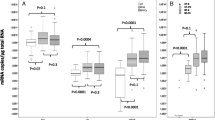Abstract
Purpose
To assay for uPA and PAI-1 in prostate tissue from 40 patients with prostatic disease and to examine the robustness of the correlation of the uPA/PAI-1 ratio with benign prostatic hyperplasia (BPH) and prostate cancer (PCa), previously identified in a different cohort of 62 patients.
Methods
uPA and PAI-1 were extracted from liquid N2 frozen homogenised prostate tissue with TRIS/Triton pH 8.5 buffer and measured by ELISA (FEMTELLE).
Results
The concentration of uPA (mean ± SD) was found to be 0.1177 ± 0.0266 (range 0.0070–0.7200; n = 30) and 0.1092 ± 0.0130 (range 0.0040–0.7800; n = 70) for PCa and BPH patients, respectively. The concentration of PAI-1 was found to be 5.236 ± 0.688 ng/mg protein (range 1.10–15.19; n = 30) and 4.975 ± 0.501 ng/mg protein (range 0.20–25.00; n = 70) for PCa and BPH patients, respectively. The mean uPA/PAI-1 ratio was found to be 0.0479 ± 0.0060 (range 0.0043–0.1200; n = 30) in PCa samples and was significantly higher than BPH samples where the ratio was 0.0332 ± 0.0023 (range 0.0040–0.0860; n = 70) (P = 0.0064). In PCa patients older than 68 years, the uPA/PAI-1 ratio was above 0.050 reaching 0.100 in 73-year-old patients.
Conclusions
Evaluation of 100 patients with prostatic pathologies (70 PCa; 30 BPH) shows the uPA/PAI-1 ratios in PCa patients to be significantly higher than in BPH patients. This is fully consistent with a previous study on 62 patients (16 were PCa; 46 BPH) where the ratios were 0.055 and 0.031 for PCa and BPH patients, respectively (P = 0.0028). In older PCa patients, uPA/PAI-1 ratios tend to be higher.



Similar content being viewed by others
References
Andreasen PA, Kjøller L, Christensen L, Duffy MJ (1997) The urokinase-type plasminogen activator system in cancer metastasis: a review. Int J Cancer 72(1):1–22
Böhm L, Serafin A, Akudugu J, Fernandez P, van der Merwe A, Aziz NA (2013) uPA/PAI-1 ratios distinguish benign prostatic hyperplasia and prostate cancer. J Cancer Res Clin Oncol 139:1221–1228
Dano K, Andreasen PA, Grondahl-Hansen J, Kristensen P, Nielsen LS, Skriver L (1985) Plasminogen activators, tissue degradation, and cancer. Adv Cancer Res 44:139–266
Egeblad M, Werb Z (2002) New functions for the matrix metalloproteinases in cancer progression. Nat Rev Cancer 2(3):161–174
Gupta A, Lotan Y, Ashfaq R, Roehrborn CG, Raj GV, Aragaki CC et al (2009) Predictive value of the differential expression of the urokinase plasminogen activation axis in radical prostatectomy patients. Eur Urol 55(5):1124–1133
Harbeck N, Schmitt M, Meisner C, Friedel C, Untch M, Schmidt M et al (2013) Ten year analysis of the prospective multicentre Chemo-N0 trial validates American Society of Clinical Oncology (ASCO)-recommended biomarkers uPA and PAI-1 for therapy decisions in node negative breast cancer patients. Eur J Cancer 49(8):1825–1835
Jänicke F, Pache L, Schmitt M, Ulm K, Thomssen C, Prechtl A et al (1994) Both the cytosols and detergent extracts of breast cancer tissues are suited to evaluate the prognostic impact of the urokinase-type plasminogen activator and its inhibitor, plasminogen activator inhibitor type 1. Cancer Res 54(10):2527–2530
Serafin AM, Akudugu JM, Böhm L (2014). Influence of freeze- drying on the recovery of the tumour invasion markers uPA and PAI-1 from prostate tissue resections. Ann Clin Biochem (in revision)
Shariat SF, Roehrborn CG, McConnel JD, Park S, Alam N, Wheeler TM et al (2007a) Association of circulating levels of the urokinase system of plasminogen activation with the presence of prostate cancer and invasion, progression and metastasis. J Clin Oncol 25:349–355
Shariat SF, Park S, Trinh QD, Roehrborn CG, Slawin KM, Karakiewicz PI (2007b) Plasminogen activation inhibitor-1 improves the predictive accuracy of prostate cancer nomograms. J Urol 178(4 Pt 1):1229–1236
Thomssen C, Vetter M, Schmidt M, Veyret C, Meisner C, von Minckwitz G et al (2009) ASCO-recommended prognostic factors uPA and PAI-1 in node negative breast cancer patients compared to clinic-pathological risk assessment in the NNBC3 Europe Trial. J Clin Oncol 27(15S):544
Vetter M, Kantelhardt EJ, Annecke K, Dittmer J, Paepke D, Prechtl A et al (2007) Invasionsfaktoren uPA/PAI-1 im Tumorgewebe bei Patientinnen mit primärem Mammakarzinom: Von Forschungsergebnissen zur klinischen Anwendung am Beispiel der NNBC 3-Europe-Studie. Geburtsh Frauenh 67:1144–1152
Yamamoto K, Takeshita K, Kojima T, Takamatsu J, Saito H (2005) Aging and plasminogen activator inhibitor (PAI-1) regulation: implication of pathogenesis of thrombotic disorders in the elderly. Cardiovasc Res 66:276–285
Acknowledgments
We thank Drs. K du Toit, J Basson, H van Heerden, S Wessels, P Fernandez, A van der Merwe and C van der Walt of the Urology Department, University of Stellenbosch, and Dr NA Aziz of the Gatesville Medical Centre, Athlone, SA for prostate resections. Work was supported by the Cancer Association of South Africa (CANSA) and the Faculty of Medicine and Health Sciences, University of Stellenbosch, to LB, and by the National Research Foundation of South Africa (NRF: Grants No. 85703 and No. 92741) to JA.
Conflict of interest
We declare that we have no conflict of interest.
Author information
Authors and Affiliations
Corresponding author
Rights and permissions
About this article
Cite this article
Akudugu, J., Serafin, A. & Böhm, L. Further evaluation of uPA and PAI-1 as biomarkers for prostatic diseases. J Cancer Res Clin Oncol 141, 627–631 (2015). https://doi.org/10.1007/s00432-014-1848-3
Received:
Accepted:
Published:
Issue Date:
DOI: https://doi.org/10.1007/s00432-014-1848-3




